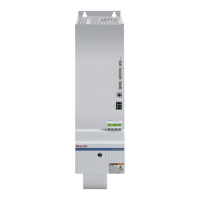Rexroth IndraDrive Requirements to the Mains Connection 10-5
DOK-INDRV*-SYSTEM*****-PR02-EN-P
Maximum Connected Load to a Mains
The maximum connected load to a mains depends on the allowed
distortion of the mains voltage due to the load current with harmonics
(mains pollution). The distortion is described by the distortion factor or the
total harmonic distortion (THD) of the mains current (see chapter
"Calculations").
In order to limit the distortion of the mains voltage take the mains short-
circuit ratio R
SC
(ratio of the source) into account:
AkNksc
SSIIR //
1
==
I
k
: mains short-circuit current
I
1N
: fundamental wave of nominal current of all loads at connection point
S
k
: mains short-circuit power
S
A
: connected load of all electric loads at connection point (apparent
power of fundamental wave)
Fig. 10-9: Mains short-circuit ratio R
sc
For public mains we distinguish
• Mains connections under 16 A: With an RSC ≥ 1000 there normally
isn't any restriction of the allowed mains current distortion (according
to EN 61000-3-2).
• Mains connections over 16 A for which the power supply company
determines the restrictions. Unless there are other values available,
the following data can be considered as guide values.
R
sc
Allowed THD of mains
current
Allowed distortion factor of
mains current
>= 1000 THD> 48% K>45%
>= 120 THD<= 48% K<=45%
> 33 THD< 13% K < 12 %
Fig. 10-10: Required THD/distortion factor with given R
sc
of the mains
(U < 600 V)
Measures to comply with the maximum allowed THD or distortion factor
are
• use of mains chokes
• use of supply units with incorporated power factor correction PFC
Note: The following fact applies to mains chokes: the higher the
inductance of the choke, the lower the TDH/distortion factor
and the mains pollution.
Measures for Compliance with
Allowed THD or Distortion
Factor

